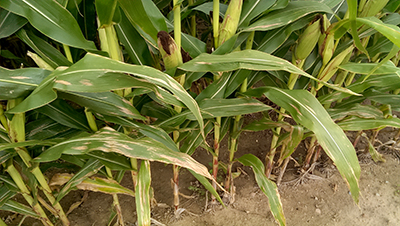Northern corn leaf blight levels high in 2014
Northern corn leaf blight is present in many Michigan fields this year.

This growing season (2014) has seen northern corn leaf blight develop at very high levels in some Michigan corn fields. Northern corn leaf blight is caused by the fungus Exserohilum turcicum, which survives the winter on corn residue. Spores of the fungus are spread by wind and rain splash. The cool, wet conditions and prolonged leaf wetness this year have been ideal for the spread of spores and infection of plants.
Northern corn leaf blight can be identified by the distinctive lesions that form on the leaves. Lesions start out as light green, but develop into the tell-tale tan or gray cigar-shaped lesions. When disease pressure is high, entire leaves may die.
Given the weather conditions this year, there appears to be some clear differences from field to field in hybrid susceptibility. For management of northern corn leaf blight, Michigan State University Extension recommends hybrids with good resistance scores should be selected. Crop rotation will reduce the amount of inoculum present at the start of the season, and tillage can also help to break down corn residue. Foliar fungicides can be used to manage northern corn leaf blight, but may not be profitable, especially given current corn prices. Factors that are likely to increase a return on a foliar fungicide investment include a history of northern corn leaf blight, tight rotations, use of a susceptible hybrid, disease pressure at tasseling and weather conditions at tasseling and during grain fill.

Corn plants with northern corn leaf blight. Note the almost complete death of leaves.



 Print
Print Email
Email




